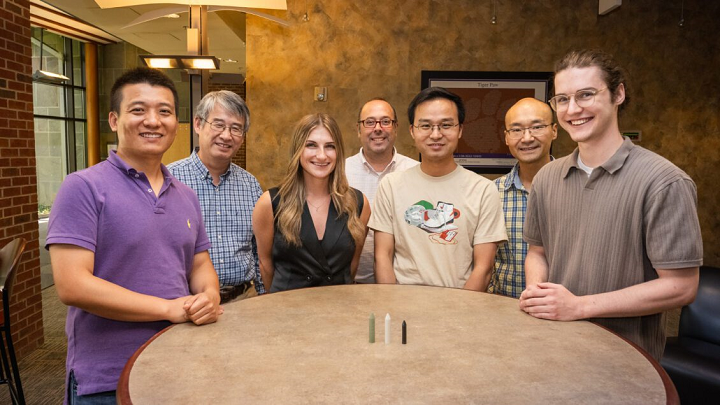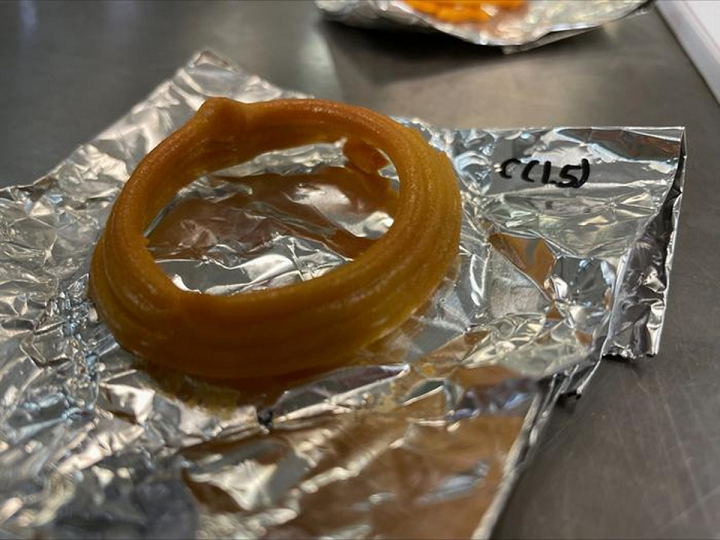3D Printing News Briefs, September 16, 2023: Certification, Fuel Cells, Microalgae Ink, & More – 3DPrint.com
In today’s 3D Printing News Briefs, we’re kicking things off with business, as former Waymo legal executive David Tressler joins 6K as its Chief Legal Officer. Moving on, MakerVerse received an important ISO certification, and Mechnano’s PK ESD has been approved for use on Farsoon’s printers. Clemson University has developed 3D printed ceramic protonic fuel cells. Researchers from National University of Singapore have been 3D printing mock-squid with microalgae. Finally, you’ll just have to see these shoes 3D printed on socks to believe them.
6K Appoints former Waymo Executive to Chief Legal Officer

David Tressler has a wealth of experience as a senior legal leader. He is well-versed in facilitating the commercialization and development of new technology, while also maturing legal and regulatory functions.
Massachusetts-headquartered 6K Inc., a leader in sustainable production of critical materials for lithium-ion batteries and additive manufacturing, has appointed David Tressler as its Chief Legal Officer. Tressler will help accelerate the global expansion of the company as the firm enters a period where it is experiencing strategic growth. He has a wealth of experience as a legal leader in commercializing new technologies, maturing compliance, regulatory, and legal functions, and supporting scaling businesses. A Harvard Law School graduate and long-serving officer in the U.S. Army Reserve, Tressler was Deputy General Counsel of autonomous driving technology company Waymo, LLC for over six years, and a partner at global law firm Kirkland & Ellis LLP in Chicago, practicing there for more than ten years. In his new role, reporting to 6K’s CEO Dr. Aaron Bent, Tressler will help support the company’s commercial growth, fundraising, M&A strategy, investments, and construction of new production facilities, including its recently announced PlusCAM, a sustainable multi-chemistry cathode manufacturing plant in Tennessee.
“6K is executing rapidly on its growth strategy to deploy investments for long-term impact. I’m thrilled to join 6K’s leadership team as the company prepares to scale its transformative, clean technology and look forward to supporting 6K’s commercial expansion,” Tressler said.
MakerVerse receives ISO 27001 certification for information security

Berlin-based startup MakerVerse has achieved the globally recognized ISO 27001:2017 certificate for information safety. The startup, also ISO 9001 certified for its quality management system, offers over 12 different manufacturing technologies, including CNC machining and 3D printing, as well as a suite of production services to help customers in making their manufacturing and quality plans. This new certification is a globally accepted standard based on requirements for establishing, implementing, and improving an information security management system (ISMS), and the criteria for achieving it is focused on data protection, information security controls, and continuous enhancement of a company’s overall ISMS. To examine the startup’s security controls, TÜV SÜD examined MakerVerse’s ISMS in an in-depth audit, including policies, procedures, and processes to safeguard services and customer information. The evaluation was a great success.
“This recognition highlights our commitment to maintaining the highest privacy and data security standards. It further emphasizes our commitment to offering unparalleled services to our customers while ensuring robust security measures are in place,” said Tim Schark, MakerVerse CFO.
Farsoon Approves Mechnano’s PK ESD Material for Printers

Global polymer and metal laser sintering systems manufacturer and supplier Farsoon, the leading supplier of industrial AM technology in China, has approved Mechnano’s PK ESD material for use with its 252P Series and Flight 403P Series machines. This laser sintering powder pairs Jabil’s PK 5000 with a coating formulation using Mechnano’s proprietary D’Func (Discrete, Dispersed, and Functionalized Carbon Nanotubes) technology. PK ESD has PK 5000’s advantages, including chemical and abrasion resistance, high impact strength, and improved elongation over general-purpose nylons, which makes it good for functional testing and production uses. Plus, the D’Func-based coating adds nano-uniform electrostatic dissipative properties to parts printed with SLS technology, giving the parts Nano-Uniform ESD at 107 Surface resistivity measured in Ohms (independent of the powder refresh rate or build orientation). Printing PK ESD on Farsoon’s systems results in accurate, high-performance parts for end-use applications like durable ESD tooling and drones.
“PK ESD’s nano uniformity is the answer to alternative ESD powder and filament solutions with unpredictable ESD performance. With Farsoon, we’re enabling the AM market by eliminating expensive and time-consuming requirements to test and validate static-dissipative performance for each part. And the fact we are doing this with a high-performance and eco-friendly material makes it even more compelling,” said Bryce Keeler, Mechnano President.
Protonic Ceramic Fuel cells 3D Printed

The research team included (from left): Jiawei Zhang, Jianhua “Joshua” Tong, Bridget Sheridan, Kyle S. Brinkman, Minda Zou, Fei Peng and Jacob Conrad.
Researchers at Clemson university have created a novel method of 3D-printing protonic ceramics fuel cells (PCFCs), with the potential to produce electricity in a more sustainable way than fossil fuels. That’s because they run on renewable fuels like ammonia, alcohols, hydrocarbons, and hydrogen, instead of petroleum or coal. But, because they’re so difficult to manufacture on a large scale, it’s been hard moving them from a laboratory setting to real-world applications. The team from Clemson’s Advanced Materials Research Laboratory (AMRL) solved this problem by 3D printing PCFCs in a tubular shape, which makes them more durable, and easier to seal, than planar designs. They published their results in ACS Energy Letters.
The researchers also 3D printed all three layers that a fuel cell requires: the anode, cathode, and electrolyte, which postdoctoral researcher and corresponding author Professor Jianhua “Joshua” Tong said has never been done before. The team used hydrogen to fuel one of the 3D printed PCFCs and found that it produced power consistently for 200-hours. Using 3D printing to fabricate this renewable energy device offers more affordability, consistency, ease of use, and precision, all of which are, as Tong said, “promising for commercialization.” It takes them about three hours to print one PCFC, and the team plans to develop a more advanced design in the future. Tong believes there’s potential for commercialization of the cells in about five years.
Researchers at National University of Singapore 3D print mock seafood

The lab prepared a 3D-printed calamari ring
The demand for environmentally friendly alternatives to seafood is growing. Researchers at NUS are using 3D-printing to create sustainable mock seafood made from plant-based materials. In their ink they used microalgae, mung beans, which are both high-protein plants, some of which have a fishy flavor. As it’s been a challenge to replicate the flavor of seafood from plant sources, while achieving the same textures and nutritional content, this was a plus. Researchers used legume protein in order to simulate the texture and flakiness found in real seafood. The proteins were combined with plant-based oils containing omega-3 fats. The team used a 3D-printer that was designed for food to deposit edible ink, and create a concept calamari. This ring had a nutritional composition similar to the real calamari rings made from squid. The team tested the smell, taste, and appearance of the calamari rings using an air-fryer after adjusting the temperature to make it easier to extrude and layer. They reported that the 3D printed rings tasted “acceptable” and had “promising texture properties.”
“The goal is to get the same texture and elastic properties as the calamari rings that are commercially available. I’m still seeing how the composition impacts the product’s elasticity and the final sensory properties,” said graduate student Poornima Vijayan, who presented the work at a meeting of the American Chemical Society.
3D printing a shoe on your socks

I’ve seen some weird 3D printed shoes, but these may take the cake: meet IMPROSOCKS, a project that was part of a Digital Fabrication course taught by Professor Dov Ganchrow at the Bezalel Academy of Art and Design. Designers Nimrod Cohen Arazuni and Noga Kamhagi 3D printed the sole of a shoe—which wraps around the top of a sock—onto the bottom part of a sock, and the parts on the upper portion were also printed from the bottom outside of the sock. A frame outside the borders of the fabric was created to print the lace-managing features, which enabled direct-to-textile printing, as well as 3D printing “in the air” around the frame. The upper part of the shoe is connected by elastic laces to provide more foot support. This strange hybrid footwear has a final look thanks to the elastic laces. The designers printed unique and personalized sole designs using Stratasys’ 3DFashion Technology.
“In analyzing the shoe-sock relationship, we realized that socks are often hidden from view, hence we decided to expose the sock and fuse the entities into one. We created a method that allows existing socks to be turned into everyday shoes. Using the advanced technology of 3D printing and scanning softwares, we allow the choice of a personal and unique design tailored to their foot shape and fashion inclination.”
Subscribe to Our Email Newsletter
Receive information and offers about 3D printing from third-party vendors.